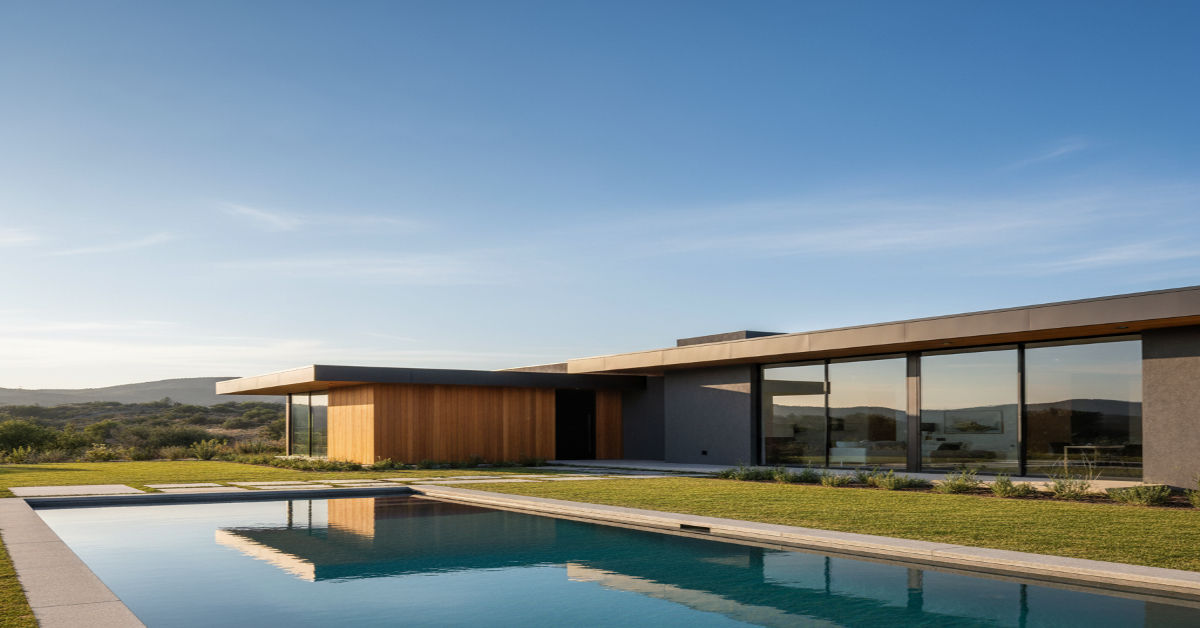A single floor house design is more than a blueprint — it’s a lifestyle statement. Imagine waking up to sunlight filtering through wide windows, moving effortlessly from your bedroom to the kitchen without climbing a single step. Every essential space — living, sleeping, dining and relaxing — exists on one graceful plane. It’s a home where accessibility meets artistry designed for comfort, connection and ease of movement.
Today’s single floor homes are a far cry from the plain ranch houses of decades past. Architects now treat them as open canvases for creativity, using flowing layouts, sculpted light and natural materials to shape experiences rather than just rooms. Without upper floors, ceilings rise higher, glass walls stretch wider and the line between indoors and outdoors almost disappears. Whether nestled in a city lot or spread across the countryside a well-designed single floor home turns simplicity into sophistication — proof that elegance doesn’t need elevation.
What Is a Single Floor House? Definition & Context
A single floor house (also known as a one-story, single-storey, or ranch-style home) is a residence with all rooms on ground level—no full upper story. Some variants include partial lofts, mezzanines, or finished basements, but the core living areas remain on one floor.
This typology is widely used in places with land availability, low-rise zoning, or climate constraints.
Why Choose a Single Floor House? Pros & Cons
Advantages
| Benefit | Explanation / Impact |
| Accessibility / Aging-in-place | No stairs means easier access for children, elderly, or those with mobility challenges. Many designers now embed features like zero-threshold showers, wider doors, etc. |
| Better flow & continuity | Rooms can connect more seamlessly without vertical breaks. |
| Lower structural complexity | Fewer load-bearing constraints, simpler structural systems, and easier maintenance (roofing, insulation, etc.). |
| Energy efficiency potential | Reduced heat transfer through stairs or vertical shafts. |
| Single-level maintenance | Cleaning, painting, and upkeep are easier when everything is ground-accessible. |
Challenges
- Footprint / land requirement: To achieve same area, you need more land.
- Potential for longer corridors: Without vertical stacking, circulation distances may grow.
- Roof span & structural load: Large roof spans require stronger beams, which can raise cost.
- Privacy & noise: Noise may travel more easily since all rooms are on one plane.
- Site constraints: Slopes or zoning setbacks may favor multi-level solutions.
Overall, the decision often boils down to site, budget, user demographics, and lifestyle preferences.
Key Design Principles for Single Floor Layouts
To make a single floor house truly perform, careful planning is vital. Below are the core principles.
4.1 Circulation & Flow
- Use central corridors / buffer zones to connect functional areas (living, sleeping, service).
- Minimize “dead ends”: avoid long hallways without purpose—turn hallways into gallery spaces or daylight connectors.
- Employ looped paths: for example from kitchen → dining → living → back to kitchen without backtracking.
4.2 Daylight & Ventilation
- Use cross-ventilation: align windows on opposite walls in key rooms.
- Place skylights, clerestory windows, light wells in deeper plans to bring daylight.
- Consider solar orientation: in hot climates, shade major glass surfaces; in cooler climates, allow solar gain.
4.3 Zoning: Private vs. Public
- Separate public zones (living, dining, kitchen) from private zones (bedrooms, baths) with buffer spaces (hallways, transitional zones).
- Use acoustic separation: walls or acoustic insulation to reduce noise between zones.
- Provide flex rooms / multipurpose zones near buffers so they can adapt (guest room, home office).
4.4 Flexibility & Futureproofing
- Use modular walls or partition systems to allow easy reconfiguration.
- Plan for aging in place: wider doors, barrier-free bathrooms, gentle level changes.
- Anticipate extensions / wings: allow for easy expansion if budget or needs change.
Popular Styles, Trends & Materials in 2025
Staying current helps your design feel fresh and market-relevant. Below are notable trends and material directions:
- Biophilic & nature integration: indoor-outdoor flow, large sliding or folding glass walls, courtyard cutouts.
- Warm minimalism: minimal forms but warmer materials (wood, natural stone, textured surfaces) rather than sterile surfaces.
- Sustainability & passive design: low embodied-energy materials (timber, recycled elements), passive solar design, rainwater harvesting, photovoltaic integration.
- Aging-in-place features: curbless showers, wide hallways, integrated handrails, universal design principles.
- Material trends: matte finishes (versus glossy), textured tiles, “color drenching” (monochrome surfaces across walls and floors)
- Rounded edges & organic shapes: less rigid right-angle dominance; softer transitions in spatial boundaries.
Design trend forecasts, like from Houzz or BuilderOnline, can help you pick elements that will remain current for at least 5–10 years.
Structural, Environmental & Regulatory Considerations
6.1 Structural Design
- Long spans require stronger roof systems—steel beams, glulam, or engineered timber are often used, with deflection control.
- Load paths must be carefully detailed to transfer roof loads to foundations directly.
- Differential settlement is critical—since all rooms sit on one plane, uneven settling is more problematic.
6.2 Climate & Site Adaptation
- In hot climates, use overhangs, verandas, shading devices, insulated roofs, and reflective surfaces.
- In cold climates, focus on insulation, passive solar gain, thermal mass, and airtightness.
- For sloped or irregular sites, consider split-level single-floor designs or integrating small steps rather than full additional floors.
6.3 Local Codes & Zoning
- Height restrictions, setback rules, FAR (floor-area ratio) limitations may restrict your footprint.
- Accessibility codes (in some jurisdictions) may require certain clearances, ramps, or barrier-free access.
- Local soil conditions, drainage, flood zones can heavily influence structural design and cost.
Make sure to collaborate with a structural engineer early in the process.
Typical Costs & Budget Drivers
Costs vary widely by region, material choices, and complexity. Below is a simple breakdown of key cost drivers and a rough cost comparison.
7.1 Key Cost Drivers
- Foundation & slab: can become expensive when soil is challenging or slab area is large.
- Roofing system / span elements: larger clear spans raise cost per square foot.
- Wall openings & glazing: increased windows and sliding walls add to cost and thermal control requirements.
- HVAC and services distribution: ducting and plumbing across the footprint may cost more than in stacked designs.
- Site preparation & earthwork: on sloped or tight sites, site work can dominate.
- Finishes & materials: from basic to premium materials—budget accordingly.
7.2 Sample Comparison
| Scenario | Approximate Cost per ft²* | Notes |
| Standard build, moderate finish | $100–150 (or local equivalent) | Basic but good quality materials |
| High-end, large spans, premium finishes | $180–250+ | Glass walls, engineered timber, custom detailing |
| Challenging site / steep slope | Add 10–30% | Extra foundation, retaining walls, drainage |
These are illustrative estimates and vary heavily by country, region, and labor/materials market. Always get local quotes.
Because there’s no upper story, material quantities are more “spread out,” which may slightly increase per-unit cost compared to a compact multi-story Single Floor House Design.
Case Studies & Real-World Examples
Real projects help ground theory in practice. The following showcase interesting approaches to single floor design.
8.1 Meadow House (Ben Waechter)
This ~2,300 sq ft, three-bedroom, two-and-a-half-bath single-story design was driven by views: the client wanted to “elevate the experience of the meadow.” The layout opens living spaces toward the landscape, with large glazed walls and carefully oriented views. This is a good example of connecting architecture with site and experiential value.
8.2 Entenza House / Case Study House
Part of the iconic Case Study House program, the Entenza House is a single-story modernist home completed in 1950 by Charles Eames and Eero Saarinen. It features open-plan living integration of interior and exterior, and the use of modular construction ideas. It remains influential as a benchmark in Single Floor House Design modern residential design.
Other Case Study Houses, such as House No. 28, also demonstrate one-story flat-roofed design with seamless indoor-outdoor flow.
These historic projects show how elegance, economy, and creativity can combine in single floor layouts.
Single Floor vs. Multi-Story for Your Site
| Factor | Single Floor | Multi-Story |
| Land requirement | Larger footprint | Smaller footprint |
| Vertical circulation cost | None / minimal | Stair costs, structural support |
| Accessibility | Excellent (no stairs) | May require lifts or ramps |
| Roof & structural spans | Requires long spans | More structural supports, less span |
| Privacy / separation | All on one plane (needs acoustic measures) | Easier vertical separation |
| Design flexibility for views | Requires good site design | Upper floors can capture views |
| HVAC / services runs | Longer runs horizontally | Shorter vertical runs |
When single floor is favored: if your land is ample, you prioritize accessibility, or your local codes encourage low-rise construction.
When multi-story might be better: in tight urban lots, steep terrain, or when you need maximum square footage in constrained land.
Conclusion & Next Steps
- A single floor house design offers accessibility, continuity, and simplicity, but demands thoughtful attention to site, structure, daylight, and circulation.
- Use the design principles (zoning, flexibility, daylight) and stay aware of Single Floor House Design trends (warm minimalism, sustainability, aging-in-place) to keep your home both timeless and functional.
- Evaluate your site constraints, budget, and long-term expansion plans carefully.
- Use the case studies above as inspiration to ground your design in reality.
Common FAQs
Q1. What’s the optimal size (sq ft) for a single floor house?
There’s no one-size-fits-all — designs run from compact (800–1,200 sq ft) to large luxury models (3,000+ sq ft). The optimal size depends on your site, budget, family needs, and local codes.
Q2. How to prevent long corridors in a single floor plan?
Use “L” or “U” shaped layouts, central hubs (like an open kitchen), or circulation loops. Bring daylight into corridors to make them feel part of living space.
Q3. Are single floor homes less energy efficient?
Not necessarily with proper insulation, orientation, shading, and envelope design, a single floor home can perform very well. The main challenge is managing roof heat gains and larger roof area.
Q4. Can I expand a single floor house later?
Yes — by adding wings or extending sideways. If you anticipate expansion, leave one side as a future addition zone (with structural “knock-out” walls or stub walls).
Q5. How do I choose between slab-on-grade vs. crawlspace or basement for single floor?
- Slab-on-grade is cost-effective and compatible with accessibility.
- Crawlspace offers access to services but adds cost and height.
- Basement allows extra storage / living space but may defeat the “single level” goal completely.







